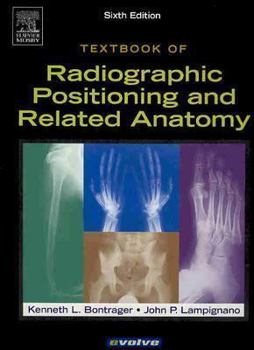Textbook of Radiographic Positioning and Related Anatomy: Textbook of Radiographic Positioning and Related Anatomy
Select Format
Select Condition 
Book Overview
This radiography text focuses on about 200 of the most commonly performed radiographic exams, featuring a clear, easy-to-follow organisation. It presents positioning and projection information in an easy-to-read, bulleted format on one side of the page spread, with corresponding positioning photos, radiographic images and anatomical drawings on the other side. Expert content covers pathology, geriatric and paediatric patient populations, survey information, and 100 new positioning photographs for the latest in radiographic positioning. The 6th edition contains a new chapter on digital imaging, and digital imaging information is incorporated where appropriate throughout the book. New photographs and redrawn illustrations create a consistent, visual appearance throughout the book. - Characterized by a clear, easy-to-follow organization that features one projection per page. Positioning and projection information is presented in an easy-to-read bulleted format on the left side of the page, and positioning photos, radiographic images and anatomical drawings are aligned on the right. This "show and tell" style helps students visualize anatomy and understand positioning.- Includes about 200 of the most commonly requested projections. Competency in performing these projections is necessary for all entry-level practitioners. By contrast, Merrill's Atlas includes over 400 projections and much more information on advanced imaging.- Critique Radiographs provide the basis of classroom or lab discussion. The WB/LM contains questions specific to these radiographs.- Pathologic Indications in appropriate chapters - Introducing pathology with positioning helps students understand the whole patient and improves their ability to produce radiographs that make diagnosis easy for the physician.- Pediatric Applications in appropriate chapters prepare technologists to deal competently with the special needs of their pediatric patients. - Geriatric Applications in appropriate chapters - Important information for technologists to understand the varying needs of their patient base.- Alternative Modalities or procedures inform students of which projections can better demonstrate certain anatomical parts or pathology, or which may be necessary if patient is unable to cooperate fully.- Radiographic Criteria on positioning pages help students develop a routine for evaluating radiographic quality.- Pathology Demonstrated provides students with a larger frame of reference, and therefore a greater understanding, of each projection
Format:Hardcover
Language:English
ISBN:0323025072
ISBN13:9780323025072
Release Date:February 2005
Publisher:Mosby
Length:872 Pages
Weight:7.83 lbs.
Dimensions:1.6" x 9.0" x 12.0"
Customer Reviews
3 ratings
Simple and Precise
Published by Thriftbooks.com User , 21 years ago
All that matters here is simplicity and precision. As the title says, Radiographis Positioning and Related Anatomy. You got what you expected: all radiographic positioning (almost all) and related anatomy (enough for x ray procedures but you really need anatomy book by your side)I highly recommend this book for reference but additional facts should be close at hand for further referrals. The Department of Diagnostic Imaging and Radiotherapy in the National University of Malaysia gives this book a definite thumbs up. I believe many universities do the same.
Xray techs you NEED this book!
Published by Thriftbooks.com User , 22 years ago
I have been an xray technologist since 1984. And I thought I knew everything about taking a chest xray...well, I did, back then. My department purchased this book last month and it is an eye opener! I read things in this book that I didn't know or had forgotten. The pictures are great, information priceless. If you are an 'old salt' like me or just a 'young pup' starting out, I highly recommend this book. You'll keep it with you throughout your career.
Good Reference for X - Ray techs.
Published by Thriftbooks.com User , 23 years ago
If you're an x - ray technician and continually do the same old procedures over and over again such as chest or back x - rays (like I do), you may become rusty on other procedures. If the dr. orders a jaw series or knee sunrise, your mind may draw a blank image of what he's talking about. I always have this book handy in my darkroom in case of these "emergencies". Once I look at the photograph/illustration and the FFD - it all comes back. I set the patient up and take the shot and run it through the processor; it always turns out right (so long as this text is with me).






